https://en.wikipedia.org/wiki/Comac_C919
Comac C919
From Wikipedia, the free encyclopedia
Jump to navigation Jump to search
C919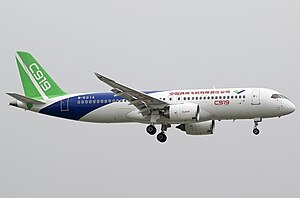 The C919 during its maiden flight on 5 May 2017 Role Narrow-body twin jet airliner National origin China Manufacturer Comac Designer Comac First flight 5 May 2017[1] Introduction Planned 2021 with China Eastern Airlines[2] Status Flight testing Number built 3 as of December 2018[3] Program cost $9.5B announced, $20B+ estimated[4]
The C919 during its maiden flight on 5 May 2017 Role Narrow-body twin jet airliner National origin China Manufacturer Comac Designer Comac First flight 5 May 2017[1] Introduction Planned 2021 with China Eastern Airlines[2] Status Flight testing Number built 3 as of December 2018[3] Program cost $9.5B announced, $20B+ estimated[4]
The Comac C919 is a narrow-body twinjet airliner developed by Chinese aerospace manufacturer Comac. The development programme was launched in 2008, production of the prototype began in December 2011, it rolled out on 2 November 2015 and the aircraft's maiden flight was on 5 May 2017. Its first commercial deliveries are expected in 2021 to China Eastern Airlines. The aircraft, primarily constructed with aluminium alloys, is to be powered by either CFM International LEAP or ACAE CJ-1000A turbofan engines, and be able to carry 156 to 168 passengers in a normal operating configuration up to 5,555 km (3000 nmi). It is intended to compete primarily with the Boeing 737 MAX and Airbus A320neo. As of 31 August 2018, Comac has 1008 commitments including 305 firm orders, mostly from Chinese leasing companies or airlines with the exception of GE.
Contents
For the model number, the C stands for "COMAC" and "China"; 9 is a homophonic pun in Chinese with "forever"; while 19 refers to its capacity of 190 passengers.[5] The C also has the implication that forms an "ABC" parallel situation with Airbus and Boeing.[6] In Mandarin Chinese, 9 (Chinese: 九; pinyin: jiǔ) is a homophone of 久, meaning "forever" as a Chengyu in Chinese: 天长地久; pinyin: tiān cháng dì jiǔ.
Development

Model of the C919 from 2010.
The 2008 program launch initially targeted a maiden flight in 2014.[7] Comac applied for a type certificate for the aircraft from the Civil Aviation Authority of China on 28 October 2010.[8] The company intends to manufacture up to 2,300 aircraft of that type.[9] In June 2011, COMAC and Irish low-cost airline Ryanair signed an agreement to co-operate on the development of the C919[10] In 2012 Airbus' chief strategist Marwan Lahoud was assuming that the aircraft would offer competition to Airbus by 2020.[11]
On 24 November 2011, Comac announced the completion of the joint definition phase, marking the end of the preliminary design phase for the C919, with estimated completion of the detailed design phase in 2012.[12] Production of the first C919 prototype began on 9 December 2011.[13] The C919's aerodynamics were designed with the help of the Tianhe-2 supercomputer.[14] The annual production was targeted at 150 planes by 2020.[15] Canada's Bombardier Aerospace has been collaborating since March 2012 on supply chain services, electrical systems, human interface and cockpit; and on flight training, flight-test support, and sales and marketing, from June 2013.[16]
Its announced development budget is 58 billion yuan ($9.5 billion) but its actual cost is estimated at well over $20 billion.[4] The flight testbed was expected to complete final assembly in 2014 and perform its first flight in 2015;[17] however, delivery was delayed again until 2018 due to technical difficulties and supply issues.[18] At the November 2014 Zhuhai Airshow, it was announced that the first flight would be delayed to 2017.[19] On 2 November 2015, Comac rolled out its first C919 aircraft.[20][21][22]
In May 2018, a composite wing development since 2012 was revealed years after abandoning it for a metallic one, as static and damage tolerance tests were completed, verifying the structural design and strength before full-size composite wingbox tests.[23] On 12 July, the static test aircraft simulated a 2.5g, 150% ultimate load, bending wings by nearly three metres for three seconds.[24]
Flight testing
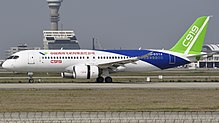
The first prototype ground tested
2017
High-speed taxi tests were completed in April 2017[25] and the first flight took place on 5 May 2017.[26] At the time, Comac has a planned test programme of 4,200 flight hours and introduction to service in 2020.[1] Slippage into 2021 was possible.[27] The European Aviation Safety Agency is working to validate the Chinese type certificate.[28] The 4,200h planned are higher than the 3,000h typically logged for the Airbus or Boeing narrowbodies, but lower than the 5,000h taken by the ARJ21.[29]
Comac powered on its second prototype on 28 July 2017, targeting to fly it within the year for engine, APU, fuel system and extreme weather tests. The first has not flown since the maiden flight but no major issues have surfaced while small improvements are being made. The flight-test plan and modules was going to be detailed and will use six aircraft.[30] On 28 September, it made its second flight at 10,000 ft (3,000 m), which lasted 2 hours 46 minutes, although it was supposed to last one more hour.[31] While the second prototype is ground tested, this five-month interval is extraordinary: in 2013 the Airbus A350 flew again after five days and in 2015 the troubled Mitsubishi MRJ flew again after eight days.[32]
On 3 November, it made its third flight in 3h 45min, reaching 3,000 m (9,800 ft).[33] It was then transferred on 10 November from Shanghai to Xian to continue its flight test campaign, a 2h 24min, 1,300 km (700 nmi) flight reaching 7,800 m (25,600 ft) and Mach 0.74 (825 km/h; 445 kn).[34]

The second prototype first flight on 17 December 2017
The second prototype made its first flight on 17 December 2017. The first three prototypes will test its performance and dynamic or power systems including the turbofans. The fourth prototype will test the mission systems, like the avionics, and the electrical system. The fifth and sixth prototypes test passengers service, including the cabin and information system.[35]
2018
The delay between first and subsequent flights underline the program immaturity by maiden flight: flying early at low speed and altitude is possible but faster and higher is limited by aeroelastic flutter needing ground vibration testing and aircraft instrumentation which were not ready in May.[36] Due to flight testing problems, the 2020 introduction previous schedule was delayed to 2021, for China Eastern Airlines.[2] In February 2018, the first prototype was flying more than once a week.[37]
In June 2018, Aviation Week reported the flight-test aircraft grounding for modifications, extending the schedule by three months but maintaining a 2020 certification target. The two prototypes were having their flaps and tailplanes modified, due to delamination of the carbon-fiber reinforced plastic elevators.[38] Flight tests should restart in July 2018, fuel tanks were also modified. The third test aircraft was also being modified and maximum-rate pressurization was tested. As three other planes will be available in 2019, Comac maintains first deliveries for 2021.[39]
Comac denied any grounding and highlighted that modifications are part of the flight test process, stating the two first aircraft were flying stability tests and checking systems. The first was calibrated and had its counterweight and trailing cone systems modified while the second had its functions and systems checked and will be transferred to the Dongying test base. The third was in final assembly with its wing and fuselage joined, cables and systems were being installed for a first flight target by the end of the year.[40] On 12 July, the second prototype flew from Shanghai-Pudong to Dongying Airport in 1h 46min to allow for various meteorological conditions testing.[24] In September, Comac expected to conduct 1,500 test flights for over 2,000 hours before the first delivery and planned to fly the third prototype before the end of 2018.[41]
In October 2018, the flight-deck design is re-evaluated to comply with US FAR Part 25.1302, not necessary for CAAC but for FAA certification to sell it outside of China, as COMAC go through the learning curve of the aircraft design process, and developing indigenous competitors for the CFM Leap-1C would take at least another 15 years.[42] By then, the two prototypes had flown less than 150 h, averaging less than 5 h per month each. To achieve certification in December 2020 and first delivery in 2021, the planned 4,200 h of flight tests would need 33 h a month each if the last four prototypes are evenly spaced before year-end-2019. Newest airliner designs like the Airbus A350 needed a 2,600 h campaign, and the Mitsubishi MRJ is expected to need 3,000 h.[43] By 2018 end, the first prototype was to enter flutter flight tests after having completed ground tests.[44] The third prototype made its maiden flight by 28 December over 1h 38 min.[3]
Design
Configuration and performance
The dimensions of the C919 are quite similar to those of the Airbus A320; its fuselage is 3.96 metres (13.0 ft) wide and 4.166 metres (13.67 ft) high with a 12.915 square metres (139.02 sq ft) cross-section. This may allow for a common unit load device to be used for both aircraft. It has a 33.6 metres (110 ft) wingspan (35.4 metres (116 ft) with winglets).[45] The aircraft's intended payload capacity will be 20.4 tonnes. The design calls for cruise at Mach 0.785 (450 kn; 834 km/h) with an operating ceiling of 12,200 metres (39,800 feet). There will be two variants: the standard version with a 4,075 km (2,200 nmi) range, and a 5,555 km (2,999 nmi) extended-range version.[45] The C919 is a cautious design, similar to the 30 years older A320.[36]
Construction
The center wing box, outer wing box, wing panels, flaps, and ailerons are planned to be built in Xi'an, China; the center fuselage sections are planned to be built in Hongdu, China.[46] Aluminium-lithium alloys account for 8.8% of the structure and composite materials for 12%.[47] The air frame will be made largely of aluminum alloy. Aircraft design and assembly is performed in Shanghai.
Wings
The wing is supercritical, increasing aerodynamic efficiency by 20% and reducing drag by 8% compared to a non-supercritical one.[48] The center wing box was originally intended to use carbon fibre composites.[9] It was changed later to an aluminum design to reduce design complications.[49]
Systems

the air conditioning made by Liebherr
The engine's nacelle, thrust reverser and exhaust system will be provided by Nexcelle, with such features as an advanced inlet configuration, the extensive use of composites and acoustic treatment and an electrically operated thrust reverser.[50] Michelin will supply Air X radial tyres.[51] Its integrated modular avionics architecture is based on Ethernet.[36] The landing gear is made in China by a joint venture of Germany's Liebherr and Avic’s Landing Gear Advanced Manufacturing Corp: Liebherr LAMC Aviation.[41]
While the airframe is entirely made by Chinese Avic, most systems are made by Western-Chinese joint-ventures: with UTAS for the electric power, fire protection and lighting; with Rockwell Collins for the cabin systems and avionics, with Thales for the IFE, with Honeywell for the flight controls, APU, wheels and brakes; with Moog for the high lift system; with Parker for the hydraulics, actuators and fuel systems, with Liebherr for the landing gear and air management; and the CFM engine and Nexcelle nacelle are entirely foreign.[52]
Engines

CFM International LEAP mockup
Both Pratt & Whitney and CFM International offered to provide the engines for the aircraft, the former offering the PW1000G and the latter the LEAP-1C;[53] the latter was ultimately selected.[54]
AVIC Commercial Aircraft Engine Co was also tasked with developing an indigenous engine to be used with the aircraft.[55] The ACAE CJ-1000A was unveiled at the 2012 Zhuhai Airshow.
The first CJ-1000AX demonstrator assembly was completed in December 2017 after an 18-month process, for an after 2021 planned service entry.[56] Debugging was completed by 30 March 2018, culminating in May 2018 with its first power-on in a test cell in Shanghai, reaching a core speed of 6,600 rpm.[57]
Market
In 2012 the C919 order book stood at 380 units worth US$26 billion,[58] and averaging $68.4 million. FlightGlobal's Ascend market values in 2013 were $49.2 million for the Airbus A320neo, 51% less than its $100.2 million list price and $51.4 million for the Boeing 737 MAX-8, 49% less than its $100.5 million list price.[59] In June 2015, the China National Radio predicted a $50 million price, cheaper than the B737 or A320 list prices.[60]
The Chinese airlines that have placed orders for the C919 already have either the Boeing 737 or Airbus A320 in their fleets.[61] In 2013, Chinese state-owned newspaper Global Times complained that an Aviation Week editorial about the bleak prospects for the aircraft "maliciously disparaged the future outlook for the C919".[62]
COMAC aims to take a fifth of the global narrowbody market and a third of the Chinese market by 2035.[7] It expects 2,000 sales in the next 20 years.[63] China considers it as a source of national pride.[64] The Financial Times states the C919 is outdated by 10–15 years compared to the latest versions of the A320 and Boeing 737, and will probably cost more to operate.[65] Its range of 2,200–3,000 nmi (4,100–5,600 km) falls short of the 3,400 and 3,550 nmi (6,300 and 6,570 km) of the A320neo and 737 Max 8, the C919 payload-range and economic are similar to the current single-aisles, but it will compete with the Neo and Max. FlightGlobal forecasts 1,209 deliveries: 687 standard and 522 stretched variants, for 85% in China.[29]
Orders
At the November 2010 Zhuhai Airshow, Comac announced orders for 55 C919 aircraft from six airlines, with an additional 45 options. The purchasing airlines or lessors included China Eastern Airlines, Air China, Hainan Airlines, China Southern Airlines, CDB Leasing Company, and GE Capital Aviation Services.[66] On 19 October 2011, Chinese ICBC Leasing ordered 45 C919s and agreed to be the launch customer.[67] On 11 November 2014, Comac announced at the 2014 Zhuhai Airshow that China Merchants Bank's aircraft leasing division made a firm commitment for 30 C919s, and that total orders were now up to 450 aircraft.[68]
At the June 2015 Paris Air Show, Ping An Leasing signed a letter of intent for 50 C919s, becoming one of Comac's largest customers, and Puren Group signed a letter of intent for seven C919s and seven ARJ21s, intended for the start-up Puren Airlines.[69] In November 2016 COMAC has received an order for 20 C919s including 5 firm from Shanghai Pudong Development Bank Financial Leasing and for 36 C919s from CITIC Group Financial Leasing including 18 firm.[70] While no down payments were needed before its maiden flight, 500,000 yuan ($76,000) were deposited subsequently for each firm order.[71] The last ICBC Leasing order for 55 on 5 December 2017 brought the order book to 785.[72] In February 2018, its total order book was for 815, before the order for 200 from HNA Group in June 2018, along 100 ARJ-21s.[73]
As of 31 August 2018, FlightGlobal recenses 305 orders plus 45 options and 658 letters of intent: 1008 commitments.[29]
Orders
Customer Firm
orders Options
LOI/MOU All Date Air China (Beijing)[66] 5 15 20 15 Nov 2010
Air China (Beijing)[66] 5 15 20 15 Nov 2010
 China Eastern Airlines, Shanghai[66] 5 15 20 15 Nov 2010
China Eastern Airlines, Shanghai[66] 5 15 20 15 Nov 2010
 China Southern Airlines, Guangzhou[66] 5 15 20 15 Nov 2010
China Southern Airlines, Guangzhou[66] 5 15 20 15 Nov 2010
 GE Capital Aviation Services (GECAS)[66] + 13 Nov 2012[74] 10 10 20 15 Nov 2010
GE Capital Aviation Services (GECAS)[66] + 13 Nov 2012[74] 10 10 20 15 Nov 2010
 Hainan Airlines, Haikou, under Grand China Air[66] 15 5 20 15 Nov 2010
Hainan Airlines, Haikou, under Grand China Air[66] 15 5 20 15 Nov 2010
 ICBC Leasing, Beijing[67] 45 19 Oct 2011
ICBC Leasing, Beijing[67] 45 19 Oct 2011
 Sichuan Airlines[75] 20 21 Oct 2011
Sichuan Airlines[75] 20 21 Oct 2011
 BOCOMM Leasing, Shanghai[76] 30 23 Nov 2011
BOCOMM Leasing, Shanghai[76] 30 23 Nov 2011
 China Aircraft Leasing Company (CALC), Hong Kong[77] 20 9 Dec 2011
China Aircraft Leasing Company (CALC), Hong Kong[77] 20 9 Dec 2011
 Bank of China – BOC Aviation[78] 20 14 Feb 2012
Bank of China – BOC Aviation[78] 20 14 Feb 2012
 China Development Bank Leasing Company, Beijing[79] 10 0 10 29 Jun 2012
China Development Bank Leasing Company, Beijing[79] 10 0 10 29 Jun 2012
 Agricultural Bank of China Financial Leasing[80] 45 2 Jul 2012
Agricultural Bank of China Financial Leasing[80] 45 2 Jul 2012
 China Construction Bank Financial Leasing[81] 26 24 50 19 Sep 2012
China Construction Bank Financial Leasing[81] 26 24 50 19 Sep 2012
 Joy Air, Xi'an[74] 20 13 Nov 2012
Joy Air, Xi'an[74] 20 13 Nov 2012
 Hebei Airlines, Shijiazhuang[74] 20 13 Nov 2012
Hebei Airlines, Shijiazhuang[74] 20 13 Nov 2012
 Industrial Bank Co. Financial Leasing, Fuzhou[82] 20 29 Oct 2013
Industrial Bank Co. Financial Leasing, Fuzhou[82] 20 29 Oct 2013
 China Merchants Bank Leasing[68] 0 30 (MOU) 30 12 Nov 2014
China Merchants Bank Leasing[68] 0 30 (MOU) 30 12 Nov 2014
 Hua Xia Bank Financial Leasing[83] 0 20 (LOI) 20 30 Jan 2015
Hua Xia Bank Financial Leasing[83] 0 20 (LOI) 20 30 Jan 2015
 Ping An Insurance Leasing, Shanghai[69] 0 50 50 17 Jun 2015
Ping An Insurance Leasing, Shanghai[69] 0 50 50 17 Jun 2015
 Puren Group
Puren Group[a][69] 0 77 17 Jun 2015
 City Airways
City Airwayshttps://en.wikipedia.org/wiki/Comac_C919#cite_note-87[86]10 (MOU)10 16 Sep 2015
 CITIC Group Financial Leasing[70] 18 18 36 1 Nov 2016
CITIC Group Financial Leasing[70] 18 18 36 1 Nov 2016
 Shanghai Pudong Development Bank Financial Leasing Co[70] 5 15 20 1 Nov 2016
Shanghai Pudong Development Bank Financial Leasing Co[70] 5 15 20 1 Nov 2016
 China Everbright Group Financial Leasing Co[87] 30 30 13 Jun 2017
China Everbright Group Financial Leasing Co[87] 30 30 13 Jun 2017
 China Nuclear E&C Group[71] 20 20 40 19 Sep 2017
China Nuclear E&C Group[71] 20 20 40 19 Sep 2017
 Huabao Leasing[71] 15 15 30 19 Sep 2017
Huabao Leasing[71] 15 15 30 19 Sep 2017
 AVIC International Leasing[71] 15 15 30 19 Sep 2017
AVIC International Leasing[71] 15 15 30 19 Sep 2017
 Agricultural Bank of China (ABC) Financial Leasing[71] 20 10 30 19 Sep 2017
Agricultural Bank of China (ABC) Financial Leasing[71] 20 10 30 19 Sep 2017
 ICBC Leasing, Beijing[72] 55 5 Dec 2017
ICBC Leasing, Beijing[72] 55 5 Dec 2017
 HNA Group[73] 200 2 Jun 2018 Total[29] 305 703 1008
HNA Group[73] 200 2 Jun 2018 Total[29] 305 703 1008
https://mil.news.sina.com.cn/china/2019-05-08/doc-ihvhiqax7316241.shtml
看到这一幕后外国网友感慨:中国就是醒来的巨龙
看到这一幕后外国网友感慨:中国就是醒来的巨龙
320
近日,一群中国年轻人成了海外社交媒体上的“网红”。
还记得两年前,中国国产大飞机C919的成功首飞吗?
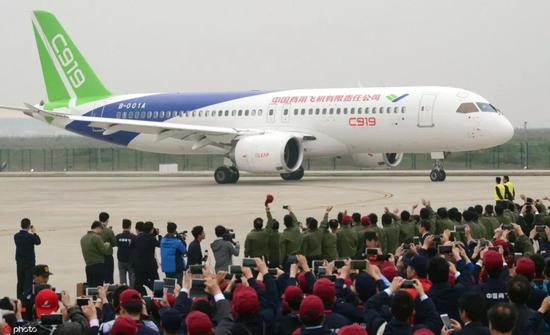 ▲资料图片:2017年5月5日,国产大飞机C919在上海首飞。(东方IC)
▲资料图片:2017年5月5日,国产大飞机C919在上海首飞。(东方IC)
如今C919正在进行商用前的试飞测试,预计将于2021年正式面向市场。而努力让大飞机的梦想照进现实的,正是一群年轻的试飞工程师。
 ▲新华社视频报道截图
▲新华社视频报道截图
试飞测试团队的工作人员共有400余名,而整个团队的平均年龄只有30岁。
这一次,新华社将镜头对准了这些幕后功臣。视频被发布在YouTube上后,海外网友赞不绝口。
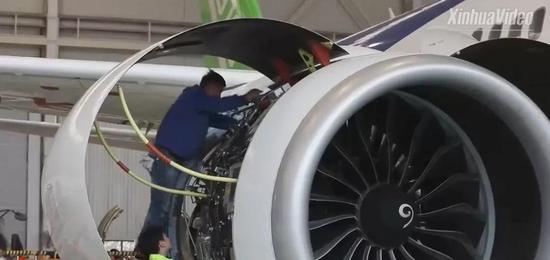 ▲新华社视频报道截图
▲新华社视频报道截图
“千里之行,始于足下。中国加油!”点赞最多的一条网友评论这样写道。

从建模到实际试飞,试飞测试工程师们通过无数个“体检项目”收集的宝贵数据,不断优化C919的性能。
甚至在2019年春节期间,工程师们也仍然坚守在工作岗位上,就是希望能达到世界一流的飞行测试水平。
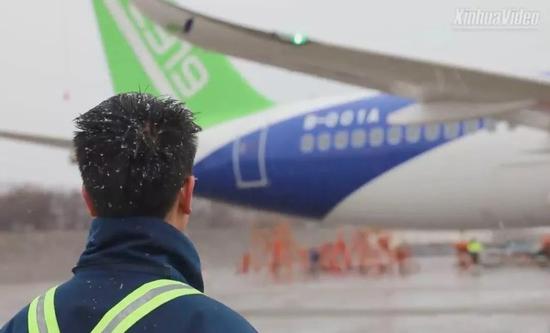 ▲新华社视频报道截图
▲新华社视频报道截图
试飞工程师赖培军在接受新华社采访时说:“想到首飞还是感觉到历历在目的。从飞机离地的那一瞬间,到整个飞机落地的那一瞬间,飞机上是没有出现任何一个告警的。首飞不出现任何一个告警其实是很难的。”
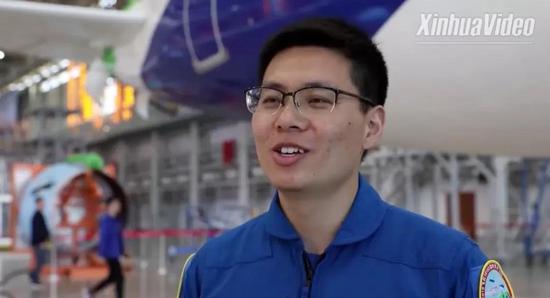 ▲试飞工程师赖培军接受新华社采访。
▲试飞工程师赖培军接受新华社采访。
成功都得益于工程师们在首飞前万无一失的准备。事实上,C919试飞工程师们在首飞前就已经完成18次滑行试验,同时准备了31份风险预案。他们还为机组人员准备了专门的逃生系统,这在此前的客机试飞测试里是没有的。
在这个年轻团队的不懈努力下,截至2018年底已经有三架C919完成首飞。
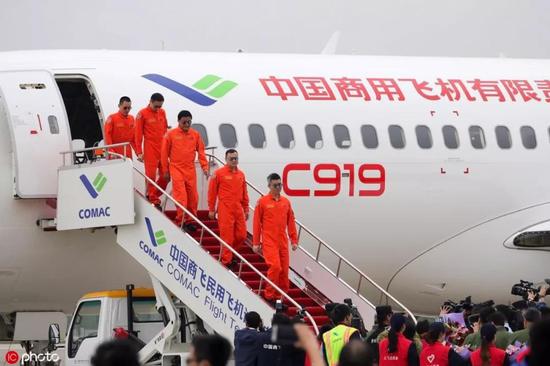 ▲完成C919空中首秀的试飞员(东方IC)
▲完成C919空中首秀的试飞员(东方IC)
新华社的视频报道还提到一个值得注意的细节,中国工程师在C919的试飞项目里还进行了很大程度的创新。
不同于以往直接进行试飞测试,中国工程师首次在飞行前先进行建模,进行预测性试飞评估。在此基础上再飞行,并根据飞行数据验证模型,同时对数据进一步分析和处理。这种创新在全世界飞机制造业都备受瞩目。
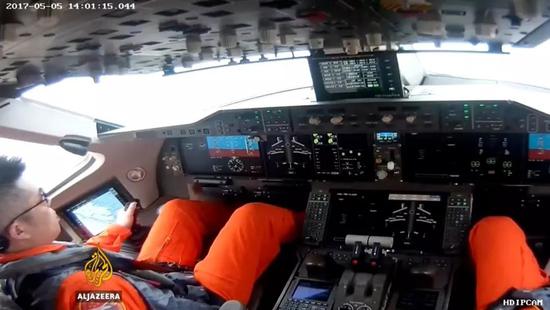 ▲C919首次飞行试验的驾驶舱(半岛电视台报道截图)
▲C919首次飞行试验的驾驶舱(半岛电视台报道截图)
在视频结尾,工程师们大喊着:“大飞机,加油!中国,加油!”
 ▲新华社视频报道截图
▲新华社视频报道截图
大批外国网友也被视频中工程师们的热情和决心感染。
在很多网友看来,这群充满朝气的年轻人,是国家发展进步最宝贵的财富。
“最关键的是,中国有这么多渴求成功的人才,不管遇到什么样的问题,他们的意志和决心都会占上风。也正是因为有了这股精气神,什么也无法阻止他们大步前进。”

很多外国网友寄予厚望:中国商用飞机有望成为波音及空客的强有力对手。“期待坐上中国飞机!”
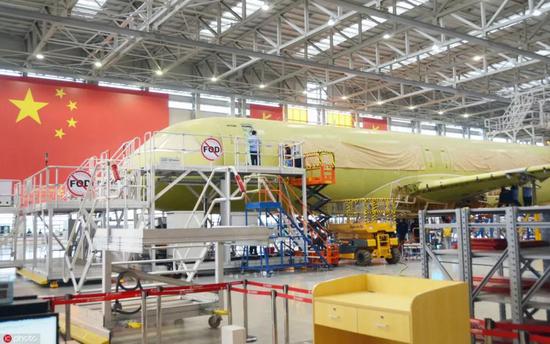 ▲资料图:工厂里的C919(东方IC)
▲资料图:工厂里的C919(东方IC)
路透社曾评价称,过去,面对发达国家的飞机制造业,中国一度难以“望其项背”。但经过中国航空人的拼搏,中国已经追赶上来了。
正如一位新加坡网友所说:中国就是醒来的巨龙,继续前进吧!

After seeing this scene, foreign netizens feel that China is the dragon that wakes up.
After seeing this scene, foreign netizens feel that China is the dragon that wakes up.
320
Recently, a group of Chinese young people have become "net red" on overseas social media.
Remember two years ago, the successful first flight of China's domestic large aircraft C919?
▲Information Picture: On May 5, 2017, the domestic large aircraft C919 made its first flight in Shanghai. (Oriental IC) ▲ Information Picture: On May 5, 2017, the domestically produced large aircraft C919 made its first flight in Shanghai. (Oriental IC)
Now the C919 is undergoing pre-commercial flight test and is expected to be officially marketed in 2021. And it is a group of young flight test engineers who are trying to make the dream of a big plane shine into reality.
▲ Xinhua News Agency video report screenshot ▲ Xinhua News Agency video report screenshot
The test flight test team has more than 400 staff members, and the average age of the entire team is only 30 years old.
This time, Xinhua News Agency directed the camera to these behind-the-scenes heroes. After the video was posted on YouTube, overseas users were full of praise.
▲ Xinhua News Agency video report screenshot ▲ Xinhua News Agency video report screenshot
“A journey of a thousand miles begins with a single step. China is cheering!” wrote a commentary with the most praise.
From modeling to actual flight testing, flight test engineers continuously optimize the performance of the C919 through valuable data collected by countless “physical inspection projects”.
Even during the Spring Festival of 2019, engineers are still sticking to their jobs, hoping to achieve world-class flight test levels.
▲ Xinhua News Agency video report screenshot ▲ Xinhua News Agency video report screenshot
Lai Peijun, a flight test engineer, said in an interview with Xinhua News Agency: "I think the first flight still feels the purpose. From the moment the plane leaves the ground, to the moment the plane landed, there was no alarm on the plane. It’s hard to get any warnings for the first flight."
▲ Flight test engineer Lai Peijun accepted an interview with Xinhua News Agency. ▲ Flight test engineer Lai Peijun accepted an interview with Xinhua News Agency.
Success has benefited from the engineers' unprepared preparations before the first flight. In fact, the C919 flight test engineers completed 18 taxi tests before the first flight and prepared 31 risk plans. They also prepared a special escape system for the crew, which was not available in the previous passenger flight test.
With the unremitting efforts of this young team, three C919s have completed their first flight by the end of 2018.
▲Complete the test pilot of the C919 air show (Oriental IC) ▲ Complete the test pilot of the C919 air show (Oriental IC)
The Xinhua News Agency's video report also mentioned a noteworthy detail, and Chinese engineers have also made a lot of innovations in the C919's flight test program.
Unlike the previous direct flight test, Chinese engineers first modeled before the flight and conducted a predictive flight test. Based on this flight, the model is validated based on the flight data, and the data is further analyzed and processed. This kind of innovation has attracted much attention in the aircraft industry worldwide.
▲ C919 first flight test cockpit (Peninsula TV report screenshot) ▲ C919 first flight test cockpit (Peninsula TV report screenshot)
At the end of the video, the engineers shouted: "Large plane, come on! China, come on!"
▲ Xinhua News Agency video report screenshot ▲ Xinhua News Agency video report screenshot
A large number of foreign netizens were also infected by the enthusiasm and determination of the engineers in the video.
In the eyes of many netizens, this group of young people full of vitality is the most valuable asset of national development and progress.
“The most important thing is that there are so many talents in China that are eager for success. No matter what kind of problems they encounter, their will and determination will prevail. It’s because of this spirit that nothing can stop them. Step forward."
Many foreign netizens have high hopes: Chinese commercial aircraft is expected to become a strong opponent of Boeing and Airbus. "I look forward to sitting on a Chinese plane!"
▲Data map: C919 (Oriental IC) in the factory ▲Data map: C919 (Oriental IC) in the factory
Reuters has commented that in the past, in the face of the aircraft manufacturing industry in developed countries, China was once difficult to "look at its back." But after the hard work of Chinese aviation people, China has already caught up.
As a Singaporean netizen said: China is the dragon that wakes up, move on!
Comac C919
From Wikipedia, the free encyclopedia
Jump to navigation Jump to search
C919
 The C919 during its maiden flight on 5 May 2017 Role Narrow-body twin jet airliner National origin China Manufacturer Comac Designer Comac First flight 5 May 2017[1] Introduction Planned 2021 with China Eastern Airlines[2] Status Flight testing Number built 3 as of December 2018[3] Program cost $9.5B announced, $20B+ estimated[4]
The C919 during its maiden flight on 5 May 2017 Role Narrow-body twin jet airliner National origin China Manufacturer Comac Designer Comac First flight 5 May 2017[1] Introduction Planned 2021 with China Eastern Airlines[2] Status Flight testing Number built 3 as of December 2018[3] Program cost $9.5B announced, $20B+ estimated[4]The Comac C919 is a narrow-body twinjet airliner developed by Chinese aerospace manufacturer Comac. The development programme was launched in 2008, production of the prototype began in December 2011, it rolled out on 2 November 2015 and the aircraft's maiden flight was on 5 May 2017. Its first commercial deliveries are expected in 2021 to China Eastern Airlines. The aircraft, primarily constructed with aluminium alloys, is to be powered by either CFM International LEAP or ACAE CJ-1000A turbofan engines, and be able to carry 156 to 168 passengers in a normal operating configuration up to 5,555 km (3000 nmi). It is intended to compete primarily with the Boeing 737 MAX and Airbus A320neo. As of 31 August 2018, Comac has 1008 commitments including 305 firm orders, mostly from Chinese leasing companies or airlines with the exception of GE.
Contents
- 1 Naming
- 2 Development
- 3 Design
- 4 Market
- 5 Orders
- 6 Specifications
- 7 See also
- 8 Notes
- 9 References
- 10 External links
For the model number, the C stands for "COMAC" and "China"; 9 is a homophonic pun in Chinese with "forever"; while 19 refers to its capacity of 190 passengers.[5] The C also has the implication that forms an "ABC" parallel situation with Airbus and Boeing.[6] In Mandarin Chinese, 9 (Chinese: 九; pinyin: jiǔ) is a homophone of 久, meaning "forever" as a Chengyu in Chinese: 天长地久; pinyin: tiān cháng dì jiǔ.
Development

Model of the C919 from 2010.
The 2008 program launch initially targeted a maiden flight in 2014.[7] Comac applied for a type certificate for the aircraft from the Civil Aviation Authority of China on 28 October 2010.[8] The company intends to manufacture up to 2,300 aircraft of that type.[9] In June 2011, COMAC and Irish low-cost airline Ryanair signed an agreement to co-operate on the development of the C919[10] In 2012 Airbus' chief strategist Marwan Lahoud was assuming that the aircraft would offer competition to Airbus by 2020.[11]
On 24 November 2011, Comac announced the completion of the joint definition phase, marking the end of the preliminary design phase for the C919, with estimated completion of the detailed design phase in 2012.[12] Production of the first C919 prototype began on 9 December 2011.[13] The C919's aerodynamics were designed with the help of the Tianhe-2 supercomputer.[14] The annual production was targeted at 150 planes by 2020.[15] Canada's Bombardier Aerospace has been collaborating since March 2012 on supply chain services, electrical systems, human interface and cockpit; and on flight training, flight-test support, and sales and marketing, from June 2013.[16]
Its announced development budget is 58 billion yuan ($9.5 billion) but its actual cost is estimated at well over $20 billion.[4] The flight testbed was expected to complete final assembly in 2014 and perform its first flight in 2015;[17] however, delivery was delayed again until 2018 due to technical difficulties and supply issues.[18] At the November 2014 Zhuhai Airshow, it was announced that the first flight would be delayed to 2017.[19] On 2 November 2015, Comac rolled out its first C919 aircraft.[20][21][22]
In May 2018, a composite wing development since 2012 was revealed years after abandoning it for a metallic one, as static and damage tolerance tests were completed, verifying the structural design and strength before full-size composite wingbox tests.[23] On 12 July, the static test aircraft simulated a 2.5g, 150% ultimate load, bending wings by nearly three metres for three seconds.[24]
Flight testing

The first prototype ground tested
2017
High-speed taxi tests were completed in April 2017[25] and the first flight took place on 5 May 2017.[26] At the time, Comac has a planned test programme of 4,200 flight hours and introduction to service in 2020.[1] Slippage into 2021 was possible.[27] The European Aviation Safety Agency is working to validate the Chinese type certificate.[28] The 4,200h planned are higher than the 3,000h typically logged for the Airbus or Boeing narrowbodies, but lower than the 5,000h taken by the ARJ21.[29]
Comac powered on its second prototype on 28 July 2017, targeting to fly it within the year for engine, APU, fuel system and extreme weather tests. The first has not flown since the maiden flight but no major issues have surfaced while small improvements are being made. The flight-test plan and modules was going to be detailed and will use six aircraft.[30] On 28 September, it made its second flight at 10,000 ft (3,000 m), which lasted 2 hours 46 minutes, although it was supposed to last one more hour.[31] While the second prototype is ground tested, this five-month interval is extraordinary: in 2013 the Airbus A350 flew again after five days and in 2015 the troubled Mitsubishi MRJ flew again after eight days.[32]
On 3 November, it made its third flight in 3h 45min, reaching 3,000 m (9,800 ft).[33] It was then transferred on 10 November from Shanghai to Xian to continue its flight test campaign, a 2h 24min, 1,300 km (700 nmi) flight reaching 7,800 m (25,600 ft) and Mach 0.74 (825 km/h; 445 kn).[34]

The second prototype first flight on 17 December 2017
The second prototype made its first flight on 17 December 2017. The first three prototypes will test its performance and dynamic or power systems including the turbofans. The fourth prototype will test the mission systems, like the avionics, and the electrical system. The fifth and sixth prototypes test passengers service, including the cabin and information system.[35]
2018
The delay between first and subsequent flights underline the program immaturity by maiden flight: flying early at low speed and altitude is possible but faster and higher is limited by aeroelastic flutter needing ground vibration testing and aircraft instrumentation which were not ready in May.[36] Due to flight testing problems, the 2020 introduction previous schedule was delayed to 2021, for China Eastern Airlines.[2] In February 2018, the first prototype was flying more than once a week.[37]
In June 2018, Aviation Week reported the flight-test aircraft grounding for modifications, extending the schedule by three months but maintaining a 2020 certification target. The two prototypes were having their flaps and tailplanes modified, due to delamination of the carbon-fiber reinforced plastic elevators.[38] Flight tests should restart in July 2018, fuel tanks were also modified. The third test aircraft was also being modified and maximum-rate pressurization was tested. As three other planes will be available in 2019, Comac maintains first deliveries for 2021.[39]
Comac denied any grounding and highlighted that modifications are part of the flight test process, stating the two first aircraft were flying stability tests and checking systems. The first was calibrated and had its counterweight and trailing cone systems modified while the second had its functions and systems checked and will be transferred to the Dongying test base. The third was in final assembly with its wing and fuselage joined, cables and systems were being installed for a first flight target by the end of the year.[40] On 12 July, the second prototype flew from Shanghai-Pudong to Dongying Airport in 1h 46min to allow for various meteorological conditions testing.[24] In September, Comac expected to conduct 1,500 test flights for over 2,000 hours before the first delivery and planned to fly the third prototype before the end of 2018.[41]
In October 2018, the flight-deck design is re-evaluated to comply with US FAR Part 25.1302, not necessary for CAAC but for FAA certification to sell it outside of China, as COMAC go through the learning curve of the aircraft design process, and developing indigenous competitors for the CFM Leap-1C would take at least another 15 years.[42] By then, the two prototypes had flown less than 150 h, averaging less than 5 h per month each. To achieve certification in December 2020 and first delivery in 2021, the planned 4,200 h of flight tests would need 33 h a month each if the last four prototypes are evenly spaced before year-end-2019. Newest airliner designs like the Airbus A350 needed a 2,600 h campaign, and the Mitsubishi MRJ is expected to need 3,000 h.[43] By 2018 end, the first prototype was to enter flutter flight tests after having completed ground tests.[44] The third prototype made its maiden flight by 28 December over 1h 38 min.[3]
Design
Configuration and performance
The dimensions of the C919 are quite similar to those of the Airbus A320; its fuselage is 3.96 metres (13.0 ft) wide and 4.166 metres (13.67 ft) high with a 12.915 square metres (139.02 sq ft) cross-section. This may allow for a common unit load device to be used for both aircraft. It has a 33.6 metres (110 ft) wingspan (35.4 metres (116 ft) with winglets).[45] The aircraft's intended payload capacity will be 20.4 tonnes. The design calls for cruise at Mach 0.785 (450 kn; 834 km/h) with an operating ceiling of 12,200 metres (39,800 feet). There will be two variants: the standard version with a 4,075 km (2,200 nmi) range, and a 5,555 km (2,999 nmi) extended-range version.[45] The C919 is a cautious design, similar to the 30 years older A320.[36]
Construction
The center wing box, outer wing box, wing panels, flaps, and ailerons are planned to be built in Xi'an, China; the center fuselage sections are planned to be built in Hongdu, China.[46] Aluminium-lithium alloys account for 8.8% of the structure and composite materials for 12%.[47] The air frame will be made largely of aluminum alloy. Aircraft design and assembly is performed in Shanghai.
Wings
The wing is supercritical, increasing aerodynamic efficiency by 20% and reducing drag by 8% compared to a non-supercritical one.[48] The center wing box was originally intended to use carbon fibre composites.[9] It was changed later to an aluminum design to reduce design complications.[49]
Systems

the air conditioning made by Liebherr
The engine's nacelle, thrust reverser and exhaust system will be provided by Nexcelle, with such features as an advanced inlet configuration, the extensive use of composites and acoustic treatment and an electrically operated thrust reverser.[50] Michelin will supply Air X radial tyres.[51] Its integrated modular avionics architecture is based on Ethernet.[36] The landing gear is made in China by a joint venture of Germany's Liebherr and Avic’s Landing Gear Advanced Manufacturing Corp: Liebherr LAMC Aviation.[41]
While the airframe is entirely made by Chinese Avic, most systems are made by Western-Chinese joint-ventures: with UTAS for the electric power, fire protection and lighting; with Rockwell Collins for the cabin systems and avionics, with Thales for the IFE, with Honeywell for the flight controls, APU, wheels and brakes; with Moog for the high lift system; with Parker for the hydraulics, actuators and fuel systems, with Liebherr for the landing gear and air management; and the CFM engine and Nexcelle nacelle are entirely foreign.[52]
Engines

CFM International LEAP mockup
Both Pratt & Whitney and CFM International offered to provide the engines for the aircraft, the former offering the PW1000G and the latter the LEAP-1C;[53] the latter was ultimately selected.[54]
AVIC Commercial Aircraft Engine Co was also tasked with developing an indigenous engine to be used with the aircraft.[55] The ACAE CJ-1000A was unveiled at the 2012 Zhuhai Airshow.
The first CJ-1000AX demonstrator assembly was completed in December 2017 after an 18-month process, for an after 2021 planned service entry.[56] Debugging was completed by 30 March 2018, culminating in May 2018 with its first power-on in a test cell in Shanghai, reaching a core speed of 6,600 rpm.[57]
Market
In 2012 the C919 order book stood at 380 units worth US$26 billion,[58] and averaging $68.4 million. FlightGlobal's Ascend market values in 2013 were $49.2 million for the Airbus A320neo, 51% less than its $100.2 million list price and $51.4 million for the Boeing 737 MAX-8, 49% less than its $100.5 million list price.[59] In June 2015, the China National Radio predicted a $50 million price, cheaper than the B737 or A320 list prices.[60]
The Chinese airlines that have placed orders for the C919 already have either the Boeing 737 or Airbus A320 in their fleets.[61] In 2013, Chinese state-owned newspaper Global Times complained that an Aviation Week editorial about the bleak prospects for the aircraft "maliciously disparaged the future outlook for the C919".[62]
COMAC aims to take a fifth of the global narrowbody market and a third of the Chinese market by 2035.[7] It expects 2,000 sales in the next 20 years.[63] China considers it as a source of national pride.[64] The Financial Times states the C919 is outdated by 10–15 years compared to the latest versions of the A320 and Boeing 737, and will probably cost more to operate.[65] Its range of 2,200–3,000 nmi (4,100–5,600 km) falls short of the 3,400 and 3,550 nmi (6,300 and 6,570 km) of the A320neo and 737 Max 8, the C919 payload-range and economic are similar to the current single-aisles, but it will compete with the Neo and Max. FlightGlobal forecasts 1,209 deliveries: 687 standard and 522 stretched variants, for 85% in China.[29]
Orders
At the November 2010 Zhuhai Airshow, Comac announced orders for 55 C919 aircraft from six airlines, with an additional 45 options. The purchasing airlines or lessors included China Eastern Airlines, Air China, Hainan Airlines, China Southern Airlines, CDB Leasing Company, and GE Capital Aviation Services.[66] On 19 October 2011, Chinese ICBC Leasing ordered 45 C919s and agreed to be the launch customer.[67] On 11 November 2014, Comac announced at the 2014 Zhuhai Airshow that China Merchants Bank's aircraft leasing division made a firm commitment for 30 C919s, and that total orders were now up to 450 aircraft.[68]
At the June 2015 Paris Air Show, Ping An Leasing signed a letter of intent for 50 C919s, becoming one of Comac's largest customers, and Puren Group signed a letter of intent for seven C919s and seven ARJ21s, intended for the start-up Puren Airlines.[69] In November 2016 COMAC has received an order for 20 C919s including 5 firm from Shanghai Pudong Development Bank Financial Leasing and for 36 C919s from CITIC Group Financial Leasing including 18 firm.[70] While no down payments were needed before its maiden flight, 500,000 yuan ($76,000) were deposited subsequently for each firm order.[71] The last ICBC Leasing order for 55 on 5 December 2017 brought the order book to 785.[72] In February 2018, its total order book was for 815, before the order for 200 from HNA Group in June 2018, along 100 ARJ-21s.[73]
As of 31 August 2018, FlightGlobal recenses 305 orders plus 45 options and 658 letters of intent: 1008 commitments.[29]
Orders
Customer Firm
orders Options
LOI/MOU All Date
 Air China (Beijing)[66] 5 15 20 15 Nov 2010
Air China (Beijing)[66] 5 15 20 15 Nov 2010
 China Eastern Airlines, Shanghai[66] 5 15 20 15 Nov 2010
China Eastern Airlines, Shanghai[66] 5 15 20 15 Nov 2010
 China Southern Airlines, Guangzhou[66] 5 15 20 15 Nov 2010
China Southern Airlines, Guangzhou[66] 5 15 20 15 Nov 2010
 GE Capital Aviation Services (GECAS)[66] + 13 Nov 2012[74] 10 10 20 15 Nov 2010
GE Capital Aviation Services (GECAS)[66] + 13 Nov 2012[74] 10 10 20 15 Nov 2010
 Hainan Airlines, Haikou, under Grand China Air[66] 15 5 20 15 Nov 2010
Hainan Airlines, Haikou, under Grand China Air[66] 15 5 20 15 Nov 2010
 ICBC Leasing, Beijing[67] 45 19 Oct 2011
ICBC Leasing, Beijing[67] 45 19 Oct 2011
 Sichuan Airlines[75] 20 21 Oct 2011
Sichuan Airlines[75] 20 21 Oct 2011
 BOCOMM Leasing, Shanghai[76] 30 23 Nov 2011
BOCOMM Leasing, Shanghai[76] 30 23 Nov 2011
 China Aircraft Leasing Company (CALC), Hong Kong[77] 20 9 Dec 2011
China Aircraft Leasing Company (CALC), Hong Kong[77] 20 9 Dec 2011
 Bank of China – BOC Aviation[78] 20 14 Feb 2012
Bank of China – BOC Aviation[78] 20 14 Feb 2012
 China Development Bank Leasing Company, Beijing[79] 10 0 10 29 Jun 2012
China Development Bank Leasing Company, Beijing[79] 10 0 10 29 Jun 2012
 Agricultural Bank of China Financial Leasing[80] 45 2 Jul 2012
Agricultural Bank of China Financial Leasing[80] 45 2 Jul 2012
 China Construction Bank Financial Leasing[81] 26 24 50 19 Sep 2012
China Construction Bank Financial Leasing[81] 26 24 50 19 Sep 2012
 Joy Air, Xi'an[74] 20 13 Nov 2012
Joy Air, Xi'an[74] 20 13 Nov 2012
 Hebei Airlines, Shijiazhuang[74] 20 13 Nov 2012
Hebei Airlines, Shijiazhuang[74] 20 13 Nov 2012
 Industrial Bank Co. Financial Leasing, Fuzhou[82] 20 29 Oct 2013
Industrial Bank Co. Financial Leasing, Fuzhou[82] 20 29 Oct 2013
 China Merchants Bank Leasing[68] 0 30 (MOU) 30 12 Nov 2014
China Merchants Bank Leasing[68] 0 30 (MOU) 30 12 Nov 2014
 Hua Xia Bank Financial Leasing[83] 0 20 (LOI) 20 30 Jan 2015
Hua Xia Bank Financial Leasing[83] 0 20 (LOI) 20 30 Jan 2015
 Ping An Insurance Leasing, Shanghai[69] 0 50 50 17 Jun 2015
Ping An Insurance Leasing, Shanghai[69] 0 50 50 17 Jun 2015  Puren Group
Puren Group City Airways
City Airways CITIC Group Financial Leasing[70] 18 18 36 1 Nov 2016
CITIC Group Financial Leasing[70] 18 18 36 1 Nov 2016
 Shanghai Pudong Development Bank Financial Leasing Co[70] 5 15 20 1 Nov 2016
Shanghai Pudong Development Bank Financial Leasing Co[70] 5 15 20 1 Nov 2016
 China Everbright Group Financial Leasing Co[87] 30 30 13 Jun 2017
China Everbright Group Financial Leasing Co[87] 30 30 13 Jun 2017
 China Nuclear E&C Group[71] 20 20 40 19 Sep 2017
China Nuclear E&C Group[71] 20 20 40 19 Sep 2017
 Huabao Leasing[71] 15 15 30 19 Sep 2017
Huabao Leasing[71] 15 15 30 19 Sep 2017
 AVIC International Leasing[71] 15 15 30 19 Sep 2017
AVIC International Leasing[71] 15 15 30 19 Sep 2017
 Agricultural Bank of China (ABC) Financial Leasing[71] 20 10 30 19 Sep 2017
Agricultural Bank of China (ABC) Financial Leasing[71] 20 10 30 19 Sep 2017
 ICBC Leasing, Beijing[72] 55 5 Dec 2017
ICBC Leasing, Beijing[72] 55 5 Dec 2017
 HNA Group[73] 200 2 Jun 2018 Total[29] 305 703 1008
HNA Group[73] 200 2 Jun 2018 Total[29] 305 703 1008 https://mil.news.sina.com.cn/china/2019-05-08/doc-ihvhiqax7316241.shtml
看到这一幕后外国网友感慨:中国就是醒来的巨龙
看到这一幕后外国网友感慨:中国就是醒来的巨龙
320
近日,一群中国年轻人成了海外社交媒体上的“网红”。
还记得两年前,中国国产大飞机C919的成功首飞吗?

如今C919正在进行商用前的试飞测试,预计将于2021年正式面向市场。而努力让大飞机的梦想照进现实的,正是一群年轻的试飞工程师。

试飞测试团队的工作人员共有400余名,而整个团队的平均年龄只有30岁。
这一次,新华社将镜头对准了这些幕后功臣。视频被发布在YouTube上后,海外网友赞不绝口。

“千里之行,始于足下。中国加油!”点赞最多的一条网友评论这样写道。

从建模到实际试飞,试飞测试工程师们通过无数个“体检项目”收集的宝贵数据,不断优化C919的性能。
甚至在2019年春节期间,工程师们也仍然坚守在工作岗位上,就是希望能达到世界一流的飞行测试水平。

试飞工程师赖培军在接受新华社采访时说:“想到首飞还是感觉到历历在目的。从飞机离地的那一瞬间,到整个飞机落地的那一瞬间,飞机上是没有出现任何一个告警的。首飞不出现任何一个告警其实是很难的。”

成功都得益于工程师们在首飞前万无一失的准备。事实上,C919试飞工程师们在首飞前就已经完成18次滑行试验,同时准备了31份风险预案。他们还为机组人员准备了专门的逃生系统,这在此前的客机试飞测试里是没有的。
在这个年轻团队的不懈努力下,截至2018年底已经有三架C919完成首飞。

新华社的视频报道还提到一个值得注意的细节,中国工程师在C919的试飞项目里还进行了很大程度的创新。
不同于以往直接进行试飞测试,中国工程师首次在飞行前先进行建模,进行预测性试飞评估。在此基础上再飞行,并根据飞行数据验证模型,同时对数据进一步分析和处理。这种创新在全世界飞机制造业都备受瞩目。

在视频结尾,工程师们大喊着:“大飞机,加油!中国,加油!”

大批外国网友也被视频中工程师们的热情和决心感染。
在很多网友看来,这群充满朝气的年轻人,是国家发展进步最宝贵的财富。
“最关键的是,中国有这么多渴求成功的人才,不管遇到什么样的问题,他们的意志和决心都会占上风。也正是因为有了这股精气神,什么也无法阻止他们大步前进。”

很多外国网友寄予厚望:中国商用飞机有望成为波音及空客的强有力对手。“期待坐上中国飞机!”

路透社曾评价称,过去,面对发达国家的飞机制造业,中国一度难以“望其项背”。但经过中国航空人的拼搏,中国已经追赶上来了。
正如一位新加坡网友所说:中国就是醒来的巨龙,继续前进吧!

After seeing this scene, foreign netizens feel that China is the dragon that wakes up.
After seeing this scene, foreign netizens feel that China is the dragon that wakes up.
320
Recently, a group of Chinese young people have become "net red" on overseas social media.
Remember two years ago, the successful first flight of China's domestic large aircraft C919?
▲Information Picture: On May 5, 2017, the domestic large aircraft C919 made its first flight in Shanghai. (Oriental IC) ▲ Information Picture: On May 5, 2017, the domestically produced large aircraft C919 made its first flight in Shanghai. (Oriental IC)
Now the C919 is undergoing pre-commercial flight test and is expected to be officially marketed in 2021. And it is a group of young flight test engineers who are trying to make the dream of a big plane shine into reality.
▲ Xinhua News Agency video report screenshot ▲ Xinhua News Agency video report screenshot
The test flight test team has more than 400 staff members, and the average age of the entire team is only 30 years old.
This time, Xinhua News Agency directed the camera to these behind-the-scenes heroes. After the video was posted on YouTube, overseas users were full of praise.
▲ Xinhua News Agency video report screenshot ▲ Xinhua News Agency video report screenshot
“A journey of a thousand miles begins with a single step. China is cheering!” wrote a commentary with the most praise.
From modeling to actual flight testing, flight test engineers continuously optimize the performance of the C919 through valuable data collected by countless “physical inspection projects”.
Even during the Spring Festival of 2019, engineers are still sticking to their jobs, hoping to achieve world-class flight test levels.
▲ Xinhua News Agency video report screenshot ▲ Xinhua News Agency video report screenshot
Lai Peijun, a flight test engineer, said in an interview with Xinhua News Agency: "I think the first flight still feels the purpose. From the moment the plane leaves the ground, to the moment the plane landed, there was no alarm on the plane. It’s hard to get any warnings for the first flight."
▲ Flight test engineer Lai Peijun accepted an interview with Xinhua News Agency. ▲ Flight test engineer Lai Peijun accepted an interview with Xinhua News Agency.
Success has benefited from the engineers' unprepared preparations before the first flight. In fact, the C919 flight test engineers completed 18 taxi tests before the first flight and prepared 31 risk plans. They also prepared a special escape system for the crew, which was not available in the previous passenger flight test.
With the unremitting efforts of this young team, three C919s have completed their first flight by the end of 2018.
▲Complete the test pilot of the C919 air show (Oriental IC) ▲ Complete the test pilot of the C919 air show (Oriental IC)
The Xinhua News Agency's video report also mentioned a noteworthy detail, and Chinese engineers have also made a lot of innovations in the C919's flight test program.
Unlike the previous direct flight test, Chinese engineers first modeled before the flight and conducted a predictive flight test. Based on this flight, the model is validated based on the flight data, and the data is further analyzed and processed. This kind of innovation has attracted much attention in the aircraft industry worldwide.
▲ C919 first flight test cockpit (Peninsula TV report screenshot) ▲ C919 first flight test cockpit (Peninsula TV report screenshot)
At the end of the video, the engineers shouted: "Large plane, come on! China, come on!"
▲ Xinhua News Agency video report screenshot ▲ Xinhua News Agency video report screenshot
A large number of foreign netizens were also infected by the enthusiasm and determination of the engineers in the video.
In the eyes of many netizens, this group of young people full of vitality is the most valuable asset of national development and progress.
“The most important thing is that there are so many talents in China that are eager for success. No matter what kind of problems they encounter, their will and determination will prevail. It’s because of this spirit that nothing can stop them. Step forward."
Many foreign netizens have high hopes: Chinese commercial aircraft is expected to become a strong opponent of Boeing and Airbus. "I look forward to sitting on a Chinese plane!"
▲Data map: C919 (Oriental IC) in the factory ▲Data map: C919 (Oriental IC) in the factory
Reuters has commented that in the past, in the face of the aircraft manufacturing industry in developed countries, China was once difficult to "look at its back." But after the hard work of Chinese aviation people, China has already caught up.
As a Singaporean netizen said: China is the dragon that wakes up, move on!
